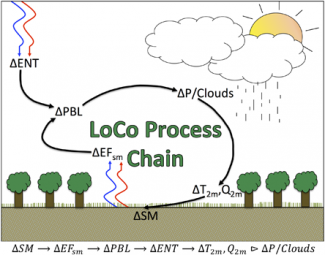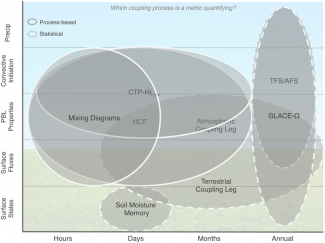Over the last two decades, the hydrometeorological community has made significant progress identifying, understanding, and quantifying the land-atmosphere (L-A) interactions that influence Earth’s water and energy cycles. Under the Global Energy and Water Exchanges (GEWEX; https://www.gewex.org) project, scientists from around the world have been studying coupled model development and improved observations of the global water and energy cycles to improve prediction of weather and climate. The GEWEX structure is composed of four focused, small-group panels of scientists. The four areas of study tasked to understand Earth’s water cycle and energy fluxes, at and below the surface and in the atmosphere, are global datasets (GDAP), atmospheric processes and models (GASS), hydroclimate applications (GHP), and land models and L-A interactions (GLASS). The GLASS LoCo working group is focused specifically on local L-A coupling (LoCo; Santanello et al. 2018), and has developed and applied coupled metrics to Earth system model development.
The LoCo project set out to develop integrative, process-level metrics to quantify complex L-A interactions and feedback that can be applied to models and observations. Specifically, the “LoCo process chain” (see figure 1) describes the water and energy-cycle pathways that connect soil moisture to clouds and precipitation via surface heat and moisture fluxes, and the evolution of the planetary boundary layer (PBL). Over the last 15 years, quantitative metrics have been developed by the LoCo working group that address specific links in this process chain. This led to the development of LoCo community resources such as Coupling Metrics “Cheat Sheets” and the Coupling Metrics Toolkit (CoMeT) to encourage the model-development communities to use these metrics.
A key feature of LoCo metrics is that they address multiple components of the coupled system as opposed to traditional “one at a time” approaches to model evaluation (see figure 2). Offline, or uncoupled model development (as was typically performed in the past for land-surface models) is suboptimal because it ignores the interaction and feedback with other components of the system (i.e., the atmosphere). Although LoCo metrics are more complex and require multiple observation inputs, which are sometimes difficult to obtain (e.g. PBL profiles), the payoff of their application is significant for a clearer understanding of the coupled processes in the models, and quantitatively assessing how new model physics, datasets, and development cycles impact those processes, including their positive and negative feedbacks. As a result, LoCo metrics are an ideal, though still underutilized, resource for the research-to-operations community because they can serve a beneficial role in facilitating the transfer of scientific knowledge and understanding to model development and, ultimately, operations.
To expand the reach of LoCo, the GEWEX community is participating in projects and outreach efforts across weather and climate modeling centers. These efforts include serving a major role in a NOAA Climate Process Team (CPT) project called CLASP (Coupling of Land and Atmospheric Subgrid Parameterizations) that convenes five climate modeling centers (NOAA, NCAR, NASA, DOE, and GFDL) and focuses on improving the L-A communication of heterogeneity in their respective global climate modeling (GCM) systems. LoCo has also been considered by the numerical weather prediction (NWP) community including NCEP, and is collaborating with DTC to incorporate LoCo metrics into their evaluation and Hierarchical System Development activities (via METplus). Although adoption has been slow, partly due to operational constraints at some of these centers, it is widely recognized that integrated and process-level metrics are an essential tool for the future improvement of Earth system models.

